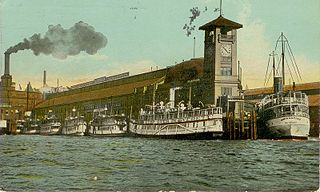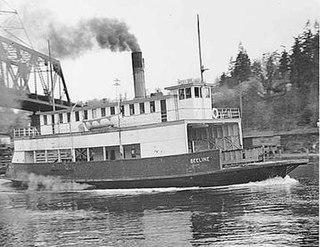
The Puget Sound mosquito fleet was a multitude of private transportation companies running smaller passenger and freight boats on Puget Sound and nearby waterways and rivers. This large group of steamers and sternwheelers plied the waters of Puget Sound, stopping at every waterfront dock. The historical period defining the beginning and end of the mosquito fleet is ambiguous, but the peak of activity occurred between the First and Second World Wars.

The sternwheeler Multnomah was built at East Portland, Oregon in 1885 and operated on the Willamette and Columbia Rivers until 1889 in the United States. She was later transferred to Puget Sound and became one of the better known steamboats operating there.

The Hunt Brothers were the owners of a steamboat business that ran on Puget Sound as part of the Puget Sound Mosquito Fleet. Five of the seven Hunt children became owners, engineers and masters of steamboats, these were Emmett E., Arthur M., Arda R., Lloyd.B., and Forest M. Hunt.

The steamboat Defiance operated in the early 1900s as part of the Puget Sound Mosquito Fleet. In later years this vessel was called Kingston.

The steamboat Monticello (2) operated in the early 1900s as part of the Puget Sound Mosquito Fleet. The vessel went through several reconstructions and remained in service until 1962, when she was lost in Alaska waters. Her later names were Penaco and Sea Venture. (This Puget Sound steamer should not be confused with the smaller Monticello, which also ran on Puget Sound, but was built in 1895 for Captain Z.J. Hatch of the Monticello Steamship Company.

The steamboat Fleetwood operated in the 1880s and 1890s on the Columbia River and later as part of the Puget Sound Mosquito Fleet.

The steamboat Rosalie operated from 1893 to 1918 as part of the Puget Sound Mosquito Fleet, also operating out of Victoria, B.C. In 1898, Rosalie went north with many other Puget Sound steamboats to join the Klondike Gold Rush.

The Greyhound was an express passenger steamer that operated from the 1890s to about 1915 on Puget Sound in Washington, United States. This vessel, commonly known as the Hound, the Pup, or the Dog, was of unusual design, having small upper works, but an enormous sternwheel. Unlike many sternwheelers, she was not intended for a dual role as passenger and freighter, but was purpose-built to carry mostly passengers on express runs.

Flyer was an American steamboat that served from 1891 to 1929 on Puget Sound. From 1918 until the end of her service, she was officially known as the Washington. The Flyer ran for millions of miles at high speed, more than any inland vessel in the world. This 1891 steamer Flyer should not be confused with the steamboat Flyer built on Lake Coeur d'Alene in 1905, although the Coeur d'Alene vessel was inspired both in design and name by the success of the Puget Sound ship.

The sidewheeler Idaho was a steamboat that ran on the Columbia River and Puget Sound from 1860 to 1898. There is some confusion as to the origins of the name; many historians have proposed it is the inspiration for the name of the State of Idaho. Considerable doubt has been cast on this due to the fact that it is unclear if the boat was named before or after the idea of 'Idaho' as a territory name was proposed. John Ruckel also allegedly stated he had named the boat after a Native American term meaning 'Gem of the Mountains' he got from a mining friend from what is now Colorado territory. This steamer should not be confused with the many other vessels of the same name, including the sternwheeler Idaho built in 1903 for service on Lake Coeur d'Alene and the steamship Idaho of the Pacific Coast Steamship Line which sank near Port Townsend, Washington.

Tacoma was a steamship that served from 1913 to 1938 on Puget Sound. Built of steel, Tacoma was known for being one of the fastest and best-designed vessels to operate on Puget Sound. Tacoma was particularly noted for high-speed service from 1913 to 1930 on the route between Tacoma and Seattle.

North Pacific was an early steamboat operating in Puget Sound, on the Columbia River, and in British Columbia and Alaska. The vessel's nickname was "the White Schooner" which was not based on the vessel's rig, but rather on speed, as "to schoon" in nautical parlance originally meant to go fast.

Burton was a steamboat built in 1905 in Tacoma, Washington and which was in service on Puget Sound until 1924.

Vashon was a wooden steamboat built in 1905 at Dockton, Washington on Vashon Island. The vessel was active on Puget Sound in the early decades of the 1900s. Vashon should not be confused with the sternwheeler Vashon which also ran on Puget Sound.

Otter was a wooden sternwheel steamboat that was used in Puget Sound and briefly on the Columbia and Stikine rivers from 1874 to 1897.

Dode was a steamboat that ran on Hood Canal and Puget Sound from 1898 to 1900.

Florence K was a steamboat that was operated on Puget Sound from 1903. This vessel was later renamed Gloria and was rebuilt as a steam ferry and renamed Beeline.

Inland Flyer was a passenger steamboat that ran on Puget Sound from 1898 to 1916. From 1910 to 1916 this vessel was known as the Mohawk. The vessel is notable as the first steamer on Puget Sound to use oil fuel. Inland Flyer was one of the most famous vessels of the time on Puget Sound.

West Seattle was a side-wheel driven steam-powered ferry built in 1907.

Concordia was a steamboat that ran on Puget Sound from 1930 to 1976. Although later converted to diesel power, Concordia was the last inland commercial steamboat ever built on either Puget Sound or the Columbia river.




















